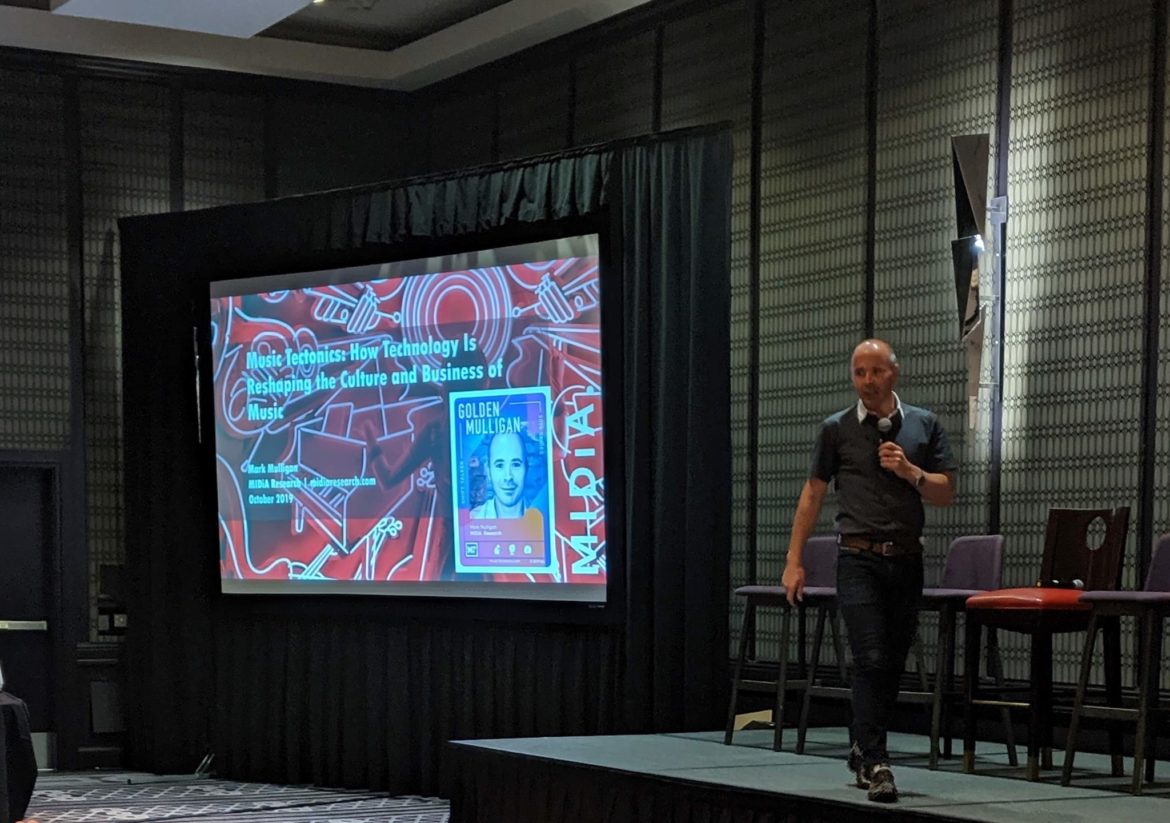Last month saw members of the entire music industry “macrosystem”, from labels and publishers and DSPs to tech startups and investors, gather for the inaugural Music Tectonics Conference in Los Angeles. The tech-focused event promised to “explore the seismic shifts that technological innovations are creating in the music industry”, and it did not disappoint. Here are our key takeaways…
Fandom is tomorrow’s currency
In his compelling keynote speech, Mark Mulligan touched on various industry trends and the ways in which technology is reshaping the culture of music. We’re at the peak of the attention economy, he explained, where innovations in any media sector will take away attention from other sectors. Netflix is now “competing with sleep”, and the music industry is competing with every other entertainment sector. But most interesting of all were his ideas about music fandom, and his belief that that the secret sauce of the next music gold rush will be figuring out how to make money from fandom, not streaming.
Though streaming has brought much needed growth to the industry, it has drastically changed our attitude towards music. “Music is now like water, but that’s not a good thing,” explained Mulligan. “Rather than something that fills you with passion, music has become a utility – something that’s just there.” Innovation that you see in the gaming world, for example, is severely lacking in the music industry. “Music used to be the single cultural identifier for youth. Nowadays, a 12 year old is more likely to define themselves as a fan of Ninja than they are of any music act,” argued Mulligan. And this is where fandom comes in. “We’re at a stage where we’ve got a real opportunity to figure out how we can bring fandom and passion back into music.”
“We’re at a stage where we’ve got a real opportunity to figure out how we can bring fandom and passion back into music.”
Mark Mulligan, MIDiA Research
According to Mulligan, we have reached a “post mainstream” era where the rules are being rewritten. Previously, we saw massive stars create cultural moments shared by all, and artists were built up through traditional channels like radio and TV. In this new era we see “fragmented fandom”, and audiences being amassed “through one niche at a time across multiple territories around the world.” With self-serving marketing tools like Facebook and Instagram, artists and labels can identify the right audience for their music and target them directly. This segmented approach will define the future of music marketing and artist success, he explained.
So what are the right strategies for surviving and thriving in this post peak, post mainstream world? To answer this question Mulligan looked to the East for inspiration: “If we look at China, Japan and South Korea, we see that it’s not music consumption being monetised, it’s music fandom,” he explained. Tencent Music, for example, is listed as a music company but the majority of its revenues are coming from live streaming, virtual gifts and currencies, and tipping, not music streaming. As a country where popular culture has recently been reinvented with the influence of social media, China offers an alternative model. “If we were starting the Western music business from scratch today, there’s no way we wouldn’t put social at the centre of it,” he said.
“If we look at China, Japan and South Korea, we see that it’s not music consumption being monetised, it’s music fandom.”
Mark Mulligan, MIDiA Research
Streaming will inevitably plateau, he explained, and in the meantime we need to find authentic places where artists and fans can engage. People are now expressing themselves through social platforms, so we need to incorporate music into those spaces. TikTok, for example, is not a music app but it’s one of the few apps that allows people to express themselves through music. “Fandom is the new currency,” according to Mulligan, and figuring out how to better engage and monetise fans will be key to the music industry’s future success. His bet is that streaming is going to get social. Watch this space…
Check out the keynote and slides in full here.
Music-tech is well beyond emergent as an investment category
The Music Tech Investor Panel, moderated by music industry journalist extraordinaire Cherie Hu, gathered prolific investors to unpack the evolving music tech investment landscape. “When I first started writing about the music tech space 4 years ago,” explained Hu, “there were almost no investment firms or accelerators focused specifically on solving issues in music, so this is a really exciting space.”
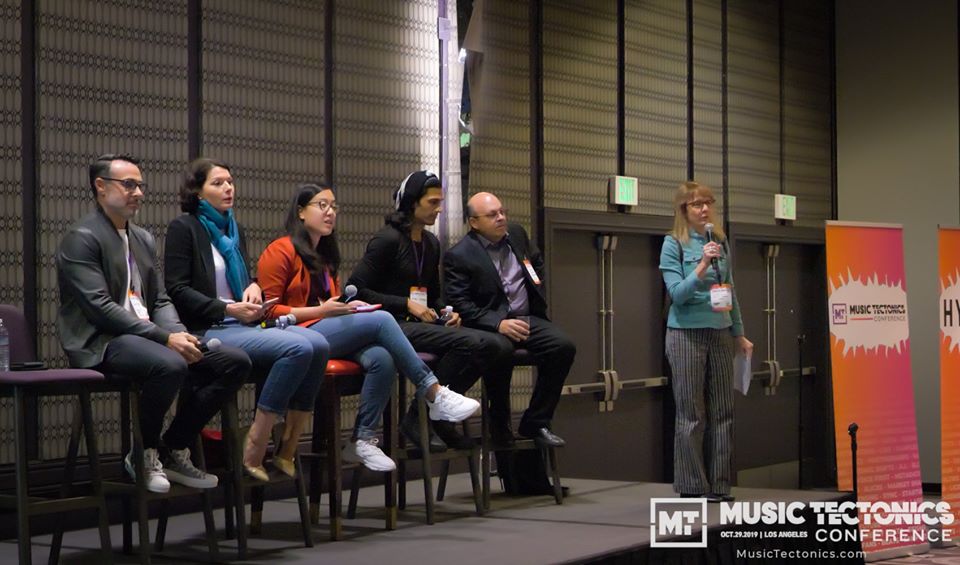
Panelists L-R: Zach Katz (Raised in Space), Virginie Berger (DBTH Capital), Cherie Hu (journalist), Rishi Patel (Plus Eight Equity Partners), Larry Marcus (Marcy Venture Partners)
Though music is an important focus for the panelists, music deals have to compete against all the other deals that they’re doing, explained Larry Marcus, who co-founded Marcy Venture Partners with Jay-Z and Jay Brown. For Rishi Patel, managing partner and co-founder of Plus Eight Equity Partners, it’s all about convergence: “How can ‘Music 2.0’ be more than just music and how does it converge with film, theatre, health and wellness, gaming, esports and so forth?”
Scooter Braun-backed Raised in Space has invested in 5 companies since their launch in January of this year, explained CEO Zach Katz, all of whom originated outside of music: “We’re helping each and every one of them come into music. We want to lead the music industry towards the next generation of transformational tech companies.” Echoing Mark Mulligan’s earlier keynote, Katz pointed out the disparity between what a 17-year old might spend each year on gaming versus what they might spend on music. “If artists in the music industry don’t lean more deeply into the relationship with their fans in the way that gamers do, we’re going to continue to get the same results,” he said.
“If artists in the music industry don’t lean more deeply into the relationship with their fans in the way that gamers do, we’re going to continue to get the same results.”
Zach Katz – CEO, Raised in Space
Meanwhile, on the rights-tech side, Virginie Berger, founder of new fund DBTH Capital, explained how companies in this space face unique challenges of their own: “Most of the time it’s a political problem rather than a tech problem. That’s why I don’t believe one company can solve the metadata or identification issue, for example.” Berger remains wary of companies claiming they can do it all, and instead tries to work with companies who “have one solution for one problem”.
“Most of the time [with rights-tech] it’s a political problem rather than a tech problem. That’s why I don’t believe one company can solve the metadata or identification issue.”
Virginie Berger – Founder, DBTH Capital
When it came to advice for pitching to the panelists, the message was clear: show expertise, have a realistic vision, and know your landscape and competition. “I have calls with people who say they want to change the licensing industry and they don’t know what DDEX is,” said Berger. And when it comes to the actual market space, over-saturation is not necessarily an issue, according to Marcus. “All of the great high value companies were in overcrowded spaces at the time of their inception, so I try to have a clean slate every day”, he explained. Perhaps most importantly of all, don’t try to bullsh** or name-check. “Every company head is one text message away from a fact check for any of us on this stage,” said Katz. “If we see one more deck containing the name Nicki Minaj trying to hawk blockchain… you’re going to turn us off.”
Though you might have more chance of getting into Harvard than getting funding, as one of the panelists joked, it’s clear that there are more places that music-tech startups can turn to for financial support than ever before.
Check out Cherie Hu’s in-depth write up of the panel here or listen to the panel discussion here.
Self-empowered artists are shifting the power dynamics of the music industry
Thanks to advances in technology, we’re witnessing a new generation of self-empowered artists doing things on their own terms. “I would argue that when it has run its course, the rise of the empowered artist is going to be a seismic shift far bigger than streaming,” said Mark Mulligan in his keynote speech. Later that day, the ‘Independent Era: How Self-Empowered Artists Are Changing the Entire Music Industry’ panel set out to explore this growing power shift and the next generation players involved.
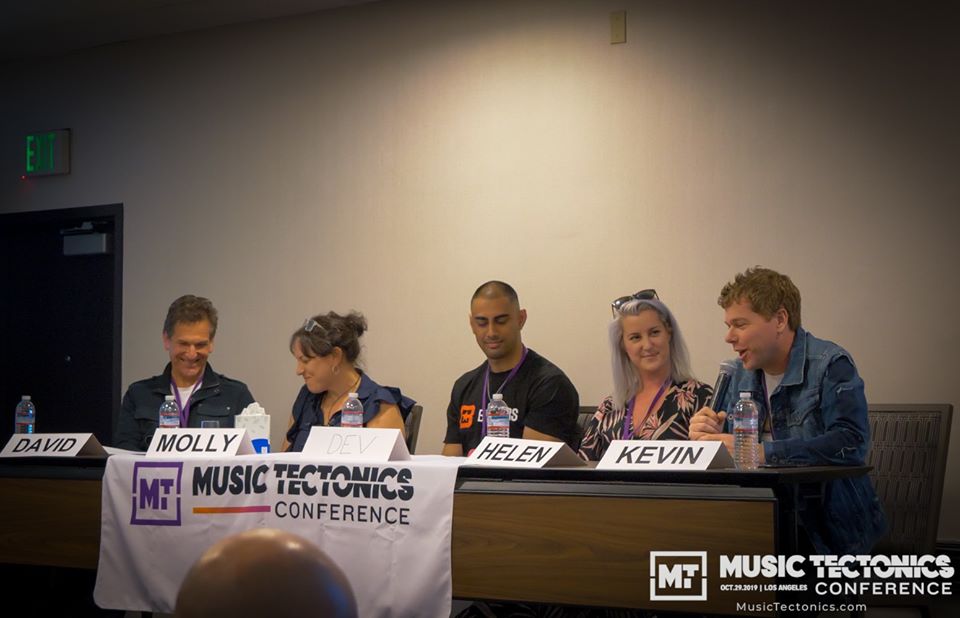
Panelists L-R: David Hazan (Midem), Molly Neuman (Songtrust), Dev Tejwani (BeatStars), Helen Sartory (The Rattle), Kevin Breuner (CD Baby)
“Independent artists previously had no access to the market without a label,” explained Kevin Breuner, VP of Marketing at CD Baby/AVL Digital. Now, a whole host of tools, apps, services and platforms are giving artists unprecedented abilities to produce, distribute, promote and monetize their music. Just look at ‘Old Town Road’, 2019’s most popular song (and the longest-running number one in American chart history). Lil Nas X purchased the beat through digital production marketplace BeatStars for just $30. “That song was created based on a buy-one-get-one-free $30 transaction,” said BeatStars’ Chief Marketing Officer Dev Tejwani.
“Traditional channels were very untargeted and unfocused, but now you can target very specific audiences online with a lot less money.”
Kevin Breuner – VP of Marketing, CD Baby/AVL Digital
While BeatStars may have been responsible for the creation of ‘Old Town Road’, its success can be largely attributed to TikTok. Artists are now able to leverage social platforms like TikTok to target audiences on a global basis. “Traditional channels were very untargeted and unfocused, but now you can target very specific audiences online with a lot less money,” explained Breuner. There’s no longer one formula for success, instead it’s all about experimentation. “With all of these different platforms in different regions you can have one song going in Mexico, one going in India, and another popping off on TikTok. This could all be part of the testing process,” said Tejwani. This has also given independent artists to move freely and quickly in the marketplace. “If something isn’t working, they can just move onto something else,” explained Breuner.
It’s these platforms that can also help proactive artists to diversify their income streams, which is more important than ever. “I don’t see any growth coming from streaming music,” said Helen Sartory, Head of Growth at incubator space The Rattle Collective. “All the growth I see is from artists doing other activities that supplement their message and create additional revenue channels for them – artists creating brands and empires that run the whole gamut of entertainment and tech.”
“All the growth I see is from artists doing other activities that supplement their message and create additional revenue channels for them – artists creating brands and empires that run the whole gamut of entertainment and tech.”
Helen Sartory – Head of Growth, The Rattle Collective
Ultimately, artists are now better equipped to make decisions about their careers and the deals they enter into, and knowledge of the industry plays a key part in that. “It’s important to us that we help artists understand how things work and what they’re owed,” explained Molly Neuman Global, Head of Business Development at Songtrust. “If you can go through independent paths and maintain ownership of your intellectual property then you’re in a really strong position,” she continued. Whether it means working with a label, self-releasing, or working with next-generation companies like CD Baby and AWAL, we should expect to see more artist-driven approaches to success and deal structures evolving in favour of creators.
Royalty systems face huge scalability challenges in the digital age
As new uses of music have emerged across streaming services, social apps and other digital platforms, royalties have become more complex than ever and systems are struggling to keep up with the sheer volume of data and payments. The ‘Rethinking Royalties: How the Entertainment Industry Can Modernize Payments’ panel gathered experts in the space, including Synchtank’s CEO Rory Bernard, to discuss these challenges and the vital role of technology in modernizing payments.
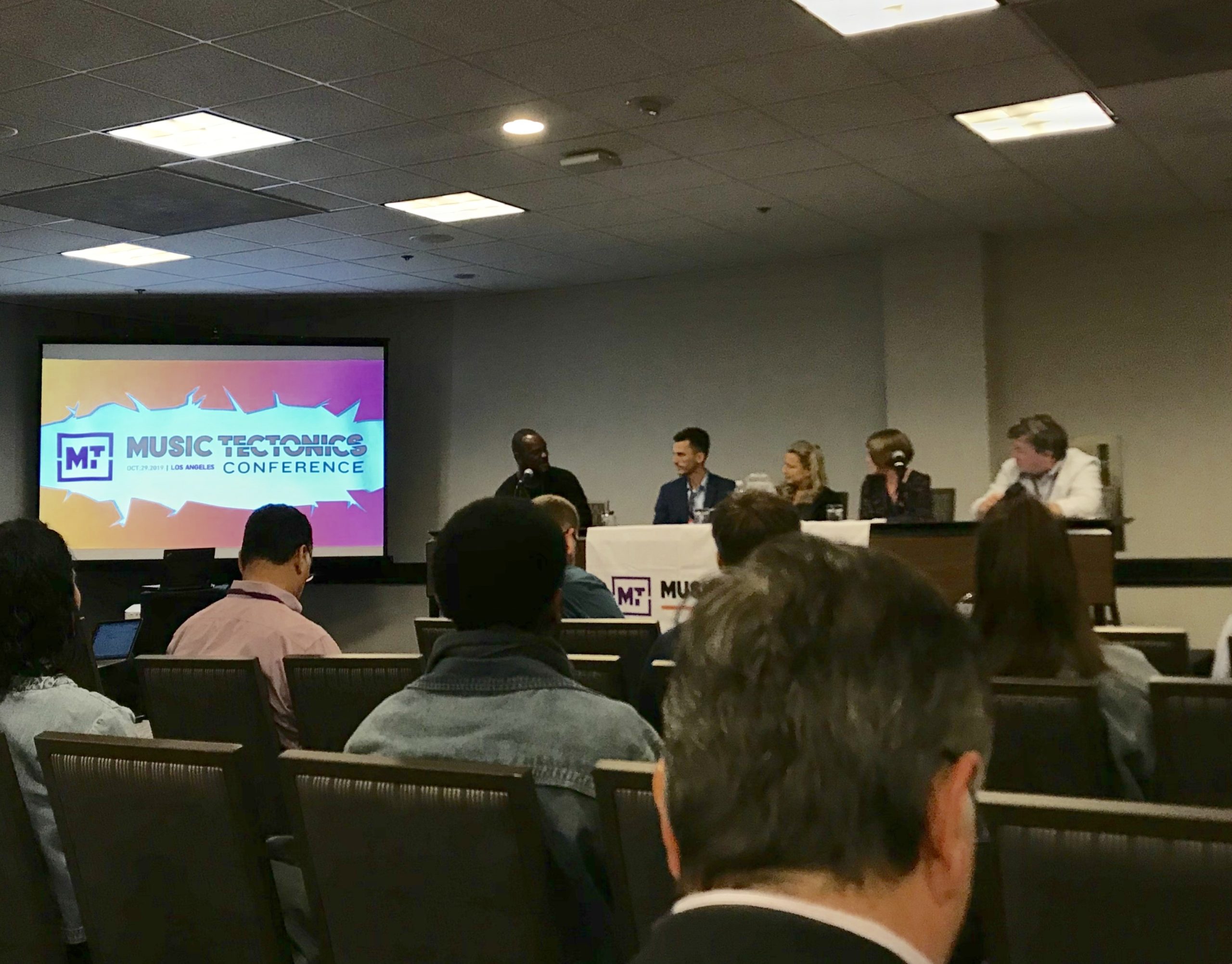
Panelists L-R: Dae Bogan (TuneRegistry/Jammber), Justin Butler (Hyperwallet), Lauren Apolito (HFA/Rumblefish), Rory Bernard (Synchtank)
Highlighting the role that technology plays at HFA/Rumblefish, SVP Strategy & Business Development Lauren Apolito explained that the organisation’s royalty systems are regularly updated to accommodate developments such as varying royalty rates and structures. “When it comes to usage reporting we’ve had to standardise all of the formats because we want to ensure that the data comes in clean,” she added. For an organisation like HFA/Rumblefish, which represents over 20 million compositions and administers rights on behalf of creators, transparency is key. “Everyone wants to know how their music is used, so we’ve enhanced our statements to include over 60 fields of data.”
According to the panelists, the biggest challenge facing royalty systems in the digital age is scalability. “Our larger clients are processing 5-10 billion rows of data a year and we’ve had to scale our systems to be able to handle that sort of throughput,” explained Synchtank CEO Rory Bernard. Processing systems need to be fast and accurate to keep up with demand. “Currently, our biggest challenge is the globalisation of music,” said Christine Barnum, CD Baby’s Senior VP of Finance & Administration. “Artists want to be paid faster and digitally so we have to meet their needs.”
“Our larger clients are processing 5-10 billion rows of data a year and we’ve had to scale our systems to be able to handle that sort of throughput.”
Rory Bernard – CEO, Synchtank
Justin Butler, Global Sales Director at payments platform Hyperwallet, claimed that the music space is far behind other spaces when it comes to the payment methods being employed. “What we hear across the music space is that it’s paper check processes or ACH if you’re lucky,” he said. Though when it came to discussing next-gen payment solutions that claim to offer real time payments based on projected royalties, the panelists were skeptical. “Real time payouts are ripe for fraud because there are always people trying to game the system,” explained Barnum. “We run payments every single week – trying to get faster than that is asking for trouble.” Butler echoed this sentiment but suggested that there’s going to be a shift in how quickly companies will be able to identify this type of fraud.
So, how can we improve and adapt royalty solutions to better service clients? For Apolito it all circes back to transparency and giving rights holders access to as many data points as possible: “The self-service portal is really what the market is seeking. Publishers want to access their own information through dashboards where they can do their own analytics.” Barnum agreed, explaining that people now expect to access data at their fingertips. And, of course, as moderator Dae Bogan of TuneRegistry/Jammber explained, it’s all about having the right technology in place: “You need the technical infrastructure in place to be able to administer against the licenses that you want to secure. Anyone getting into this space will need to think about that early on.”
“The self-service portal is really what the market is seeking. Publishers want to access their own information through dashboards where they can do their own analytics.”
Lauren Apolito – SVP Strategy & Business Development, HFA/Rumblefish
Thanks to technology we’re seeing the next generation of royalty and distribution solutions emerging and Butler thinks this will lead to more shopping around as rights holders and creators look for the best service out there. “In the gig economy 1 in 6 payees have changed platforms because of a bad experience. We’re starting to see this in the music space as well”, he explained. “You’re not necessarily tied to one channel anymore to distribute your music. Companies like CD Baby and Ingrooves are trying to shift that experience to benefit the end user.” Apolito encouraged rights holders to be as proactive as possible and ensure that the platforms administering their copyrights have proper royalty systems in place. “People often get the license but then the challenges come on the back end with the royalty administration,” she said.
======
If you were looking for a theme to summarize the entire conference, the importance of working together as an industry would be it. Though there were certainly conflicts of opinion (one of the day’s highlights was a blockchain skeptics vs. enthusiasts cage match refereed by N.W.A’s Arabian Prince), the event succeeded in gathering professionals from all parts of the music community to combine high level futurist thought with a creative and engaging experience. Definitely a must-attend conference for anyone in music tech and beyond.
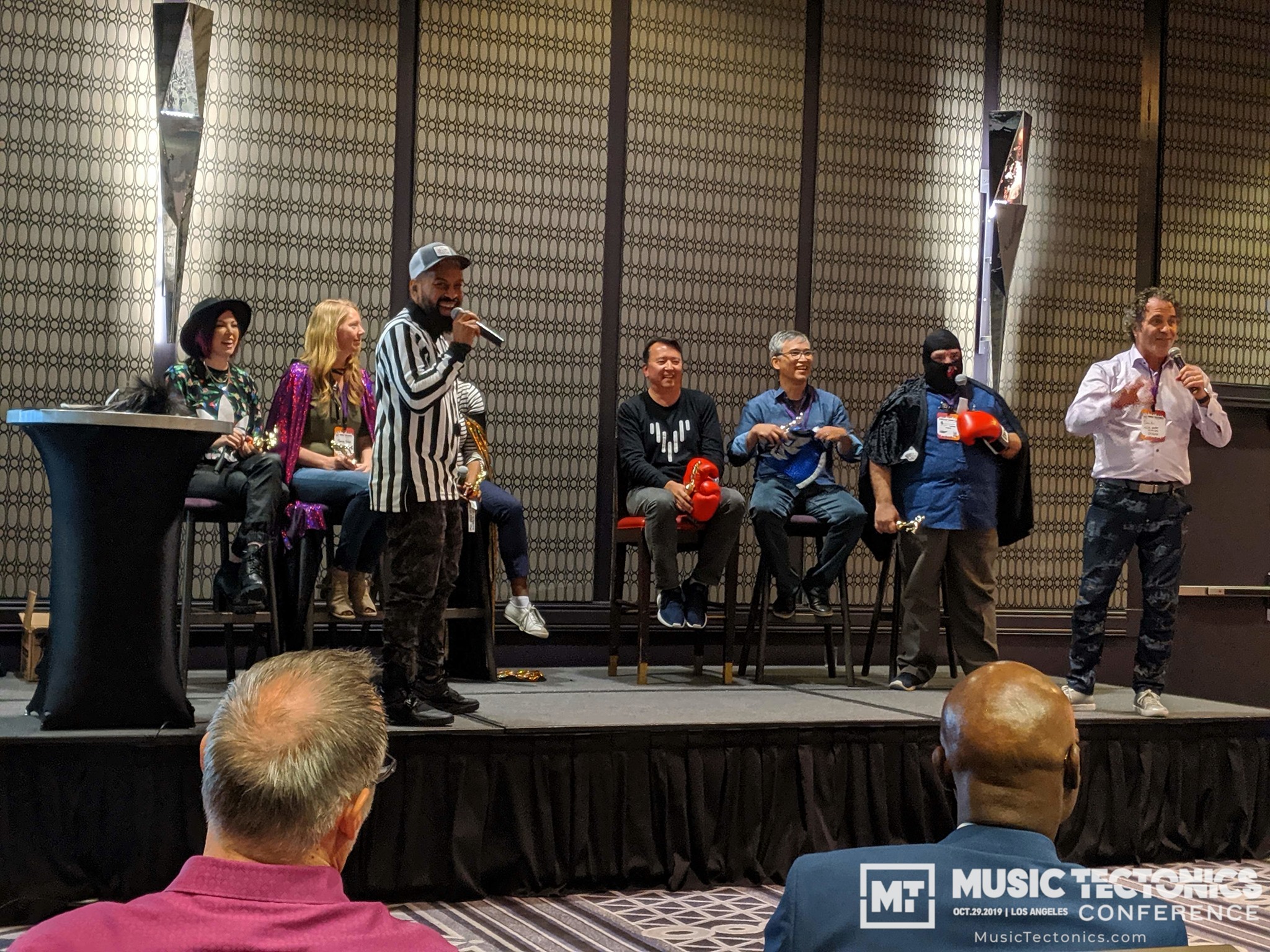
Blockchain Cage Match featuring Dani Deal (The Verge), Portia Sabin (Music Biz Association), Britnee Foreman (Songtrust), Arabian Prince (inov8next), Steve Stewart (vezt), Ken Umezaki (Verifi Media), Eddie Corral (Peer Tracks)
